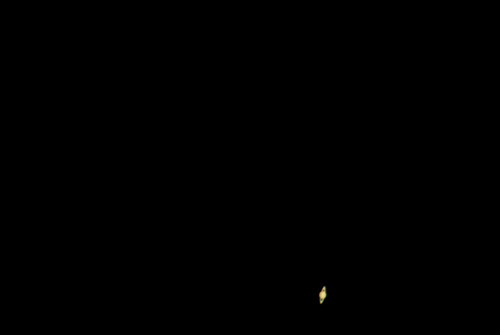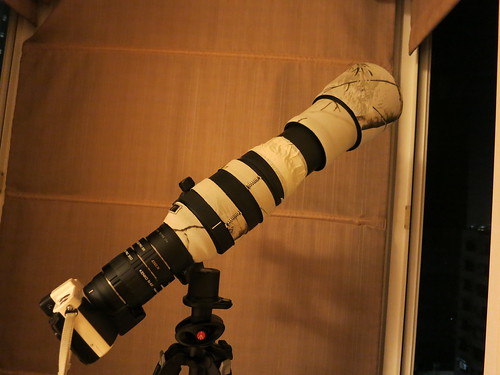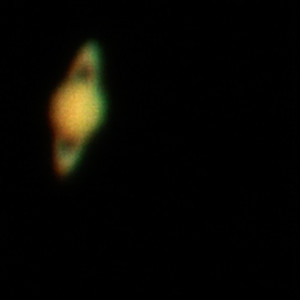Saturn at 6426mm
- Thread starter UncleFai
- Start date
You are using an out of date browser. It may not display this or other websites correctly.
You should upgrade or use an alternative browser.
You should upgrade or use an alternative browser.
WOah! didn't know that you can shoot saturn from earth using a DSLR with multiple TCs stacked together...
your camera setup is :thumbsup:
your camera setup is :thumbsup:
waaahh...this is serious.....not only amazed of the stacking of TCs and a telezoom lens but also u need to know the position of the planet as well.......RESPECT.....
For positions of the stars and planets, I relied on this wonderful iPhone app called SkyView. Also available on Android. You must try it even if you don't take photos of the stars. Really fun.
Here is what I did. I am writing this down so as to remind myself as well as share. If anyone has any suggestions to improve the flow, do let me know.
1. I modified my TC17EII by filing down the lug. Camera Hospital refused to do it for me saying "it is there for a reason". No choice, have to follow instructions online and DIY - NatureScapes.Net • View topic - Nikon stack TC 1,7 + TC 1,4
2. After Step 1, the TC17EII will couple with the Sigma 150-500mm. But for the setup to work with V1+FT1, before coupling them, I used BlueTag to force the aperture of the Sigma 150-500mm to open up to max.
3. Zoom the Siggy to max. I then use maskiing tape to tape up the zoom ring area so that it won't slide back when the whole thing is point up at 70+ degrees.
4. Set the Siggy to OS "off", manual focus. And put the focus to infinity - this is very important. Else all you see will be darkness.
5. I then couple the Kenko 1.4x TC to the Nikon TC17EII. But before doing so, I must tape up the first two rightmost electrical contacts of the TC17EII so that the Siggy will work on the V1. Otherwise, the V1 will complain no proper lens attached.
6. DO NOT fix on the Kenko 2x TC yet - as with that amount of zoom it is VERY difficult to get the planet in the viewfinder.
7. Put on the V1 + FT1. I set the V1 to grid "off", manual focus, ISO 400, shutter speed 1/20sec, electronic shutter (zero vibration), and remote trigger (using my D7000 remote trigger).
8. Put the whole contraption on the gimbal. Turn on camera.
9. Now comes the hard part. I used SkyView to locate Saturn. Then very very patiently search the quadrant (absolutely pitch black) for the bright spot. The way I do it is to free the gimbal and rock the camera in the direction of the planet. Look for streaks of light on the LCD. Need luck!
10. Hopefully you got it in the center of the viewfinder. Lock the gimbal.
11. Slap on the Kenko 2x TC. Hopefully the planet should still be in the LCD. If not, DO NOT TOUCH the horizontal lock of the gimbal. Only loosen the vertical one and very slightly move your camera up.
12. The planet is constantly on the move. You have about 20-30sec before it goes out of view. Again, loosen only the vertical lock, and tweak the setup up. As the planet moves in an arc, you may be forced to loosen the hortizonal gimbal lock and look for it - good luck! I did that 3-4 times last night. On my last try, I lost it - could not get the planet back into my viewfinder. In the end, had to throw in the towel.
13. The second hard part - manually focus.
14. Fire away using the remote. While the going is good, fire as many shots as possible, possibly tweaking focus.
15. Suppose you got 5 good shots and want to stack them. Use Photoshop to crop the images. I find that using the fixed size selector of 300 pixels by 300 pixels and locating it so that the planet end up in roughly the same position works best for stacking. Also, using levels adjustment and bring the blacks in to about 80-100.
16. Then use Registax to stack the images. RegiStax- Free image processing software
17. PP again using Photoshop to clean up.
Whew! I can't believe I did all that in the night after a full day's work
1. I modified my TC17EII by filing down the lug. Camera Hospital refused to do it for me saying "it is there for a reason". No choice, have to follow instructions online and DIY - NatureScapes.Net • View topic - Nikon stack TC 1,7 + TC 1,4
2. After Step 1, the TC17EII will couple with the Sigma 150-500mm. But for the setup to work with V1+FT1, before coupling them, I used BlueTag to force the aperture of the Sigma 150-500mm to open up to max.
3. Zoom the Siggy to max. I then use maskiing tape to tape up the zoom ring area so that it won't slide back when the whole thing is point up at 70+ degrees.
4. Set the Siggy to OS "off", manual focus. And put the focus to infinity - this is very important. Else all you see will be darkness.
5. I then couple the Kenko 1.4x TC to the Nikon TC17EII. But before doing so, I must tape up the first two rightmost electrical contacts of the TC17EII so that the Siggy will work on the V1. Otherwise, the V1 will complain no proper lens attached.
6. DO NOT fix on the Kenko 2x TC yet - as with that amount of zoom it is VERY difficult to get the planet in the viewfinder.
7. Put on the V1 + FT1. I set the V1 to grid "off", manual focus, ISO 400, shutter speed 1/20sec, electronic shutter (zero vibration), and remote trigger (using my D7000 remote trigger).
8. Put the whole contraption on the gimbal. Turn on camera.
9. Now comes the hard part. I used SkyView to locate Saturn. Then very very patiently search the quadrant (absolutely pitch black) for the bright spot. The way I do it is to free the gimbal and rock the camera in the direction of the planet. Look for streaks of light on the LCD. Need luck!
10. Hopefully you got it in the center of the viewfinder. Lock the gimbal.
11. Slap on the Kenko 2x TC. Hopefully the planet should still be in the LCD. If not, DO NOT TOUCH the horizontal lock of the gimbal. Only loosen the vertical one and very slightly move your camera up.
12. The planet is constantly on the move. You have about 20-30sec before it goes out of view. Again, loosen only the vertical lock, and tweak the setup up. As the planet moves in an arc, you may be forced to loosen the hortizonal gimbal lock and look for it - good luck! I did that 3-4 times last night. On my last try, I lost it - could not get the planet back into my viewfinder. In the end, had to throw in the towel.
13. The second hard part - manually focus.
14. Fire away using the remote. While the going is good, fire as many shots as possible, possibly tweaking focus.
15. Suppose you got 5 good shots and want to stack them. Use Photoshop to crop the images. I find that using the fixed size selector of 300 pixels by 300 pixels and locating it so that the planet end up in roughly the same position works best for stacking. Also, using levels adjustment and bring the blacks in to about 80-100.
16. Then use Registax to stack the images. RegiStax- Free image processing software
17. PP again using Photoshop to clean up.
Whew! I can't believe I did all that in the night after a full day's work
Last edited:
I am not really into astrophotography but i am still damn amazed that you can capture Saturn on yr setup, with such quality... assuming that you cropped your photo like mad...
all along i tot that such planets can only be captured by high powered telescopes via observatory... *mountaiin tortise*
all along i tot that such planets can only be captured by high powered telescopes via observatory... *mountaiin tortise*
assuming that you cropped your photo like mad...
It's not too bad. Here is what a full shot looks like (I did some photoshop to bring up the contrast and exposure):

even with the full photo, can still make out the shape. and to do that with the V1, salute man. keep it up, though not into stars photography but u really amazed me n i'm really interested to see the next series. haha..i will not really do it myself but looking at the photos is enough for me....keep it up...
UncleFai,
First I must salute your attempt. Do you think you can improve your setup further to get something like this:
SingAstro • View topic - My humble first take of Saturn...
First I must salute your attempt. Do you think you can improve your setup further to get something like this:
SingAstro • View topic - My humble first take of Saturn...
Uncle Fai, which will look bigger? The north star and the satellites orbiting our earth, or Saturn? Do you think it's possible to capture the surface of the small stuff orbiting ard our earth?
Uncle Fai, which will look bigger? The north star and the satellites orbiting our earth, or Saturn? Do you think it's possible to capture the surface of the small stuff orbiting ard our earth?
*SWEAT* The field of view from my house is very limited. But will try my luck.
UncleFai,
First I must salute your attempt. Do you think you can improve your setup further to get something like this:
SingAstro • View topic - My humble first take of Saturn...
That's very nice. I doubt if my current setup (and skills) can match that... for the moment
*SWEAT* The field of view from my house is very limited. But will try my luck.
Good luck.
I would also very humbly suggest the international space station as a likely target.
Cowseye said:Uncle Fai, which will look bigger? The north star and the satellites orbiting our earth, or Saturn? Do you think it's possible to capture the surface of the small stuff orbiting ard our earth?
çç¼ç.. Exactly what I wanted to ask..
Similar threads
- Replies
- 0
- Views
- 491
- Replies
- 0
- Views
- 659
- Replies
- 0
- Views
- 430
- Replies
- 0
- Views
- 329




